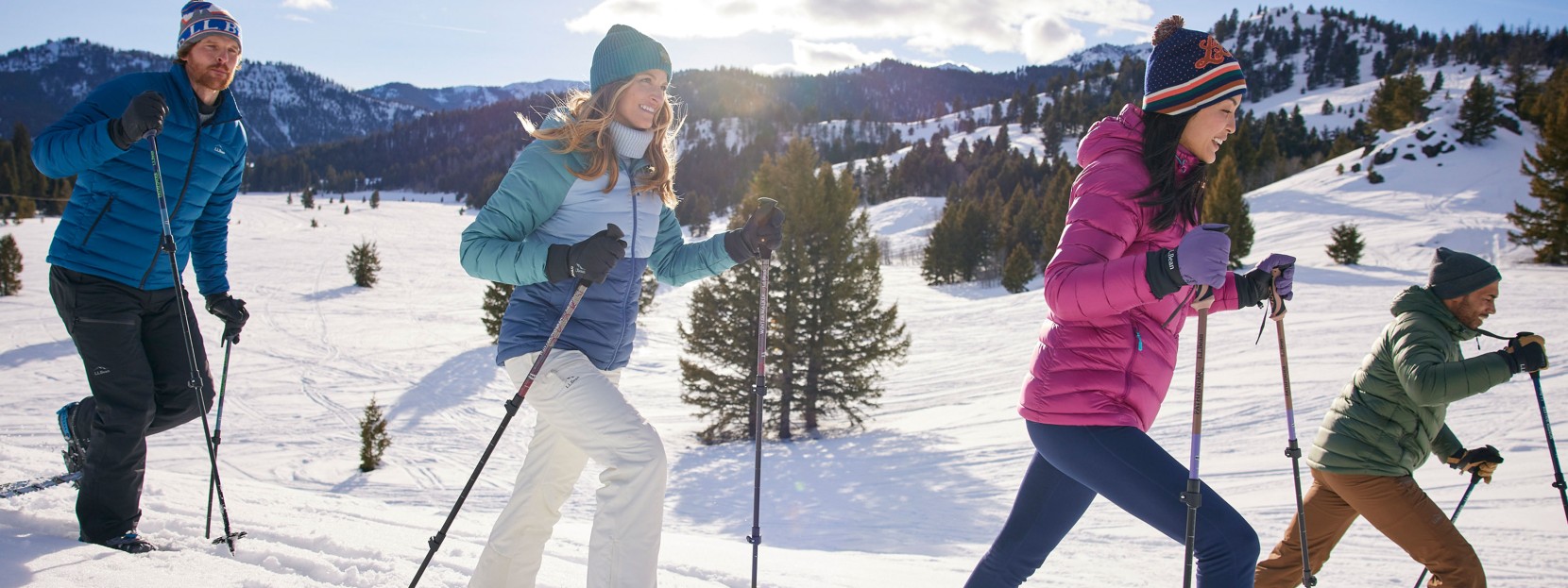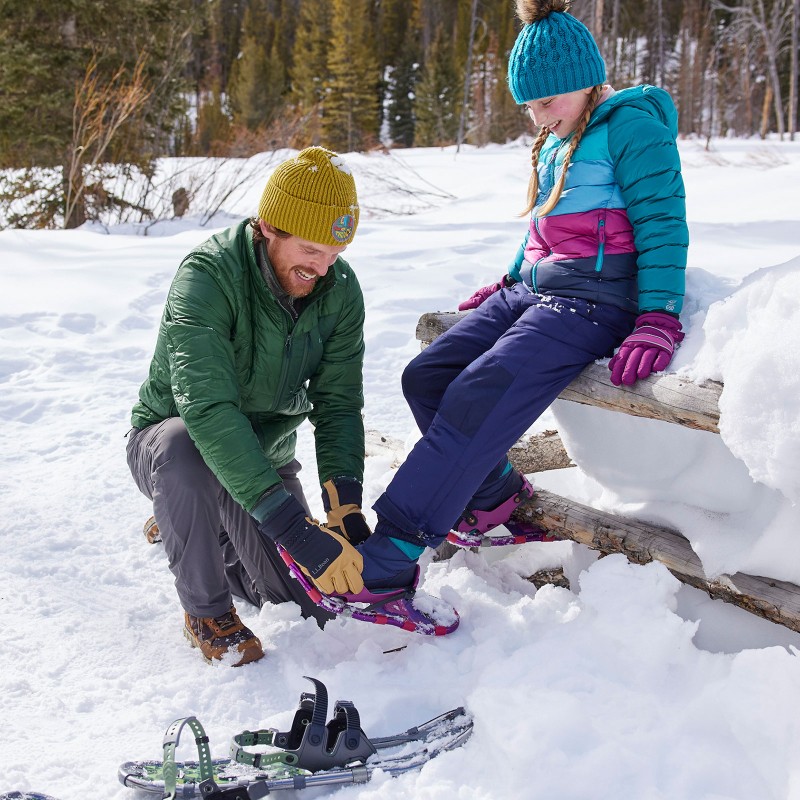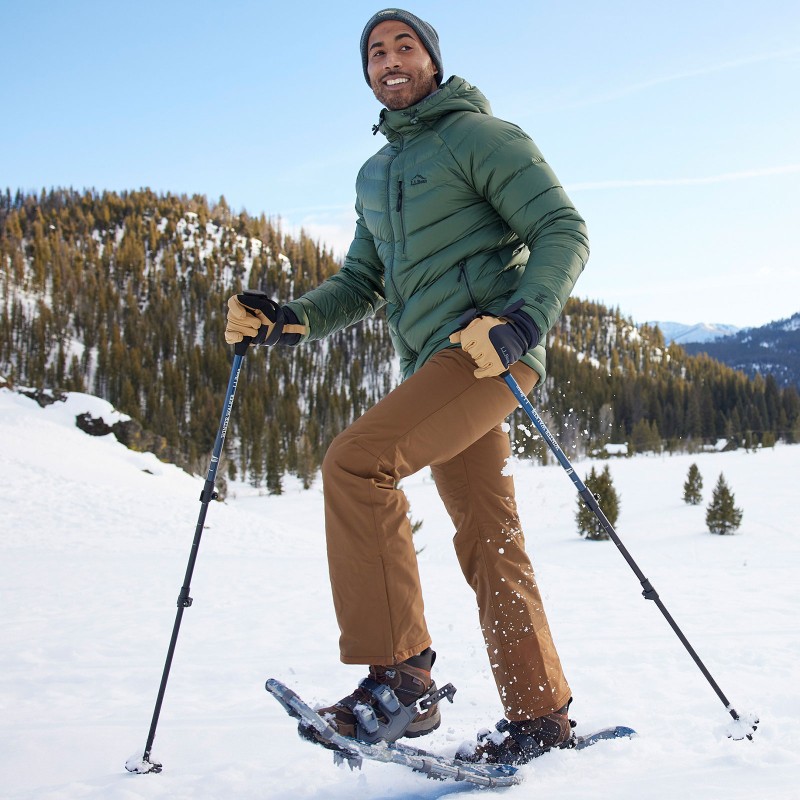
1. Where Do You Want to Snowshoe?
RECREATIONAL/BACKYARD
Walking on gentle rolling backyards, fields and wooded trails. This type of snowshoe features easy-to-use bindings, moderately aggressive crampons for traction and generally a lower price.
DAY HIKES
Hikes lasting an hour to a full day on all but the steepest, iciest terrain. Day hiking snowshoes are equipped with more aggressive crampons for traction on steeper slopes, lighter frames to make longer hikes easier and bindings that are more stable and rotate better for a more natural stride.
BACKCOUNTRY
Trips into the backcountry on rugged terrain, steep slopes and challenging conditions. These include day hikes up peaks to multiday expeditions where you’re carrying all your gear in a pack or sled. Backcountry snowshoes feature aggressive toe and rear crampons for excellent grip, heel lifts that reduce strain on steep climbs, traction rails built into the frame and advanced bindings that allow stability in all directions.
HIKING POLES
Whatever type of snowshoeing you prefer, a good pair of hiking poles will make your hikes easier. Besides helping you with balance in deep snow or steep slopes, poles will take stress off sensitive joints like knees and ankles. Be sure the poles are equipped with snow baskets so they won’t sink too deep into the powder.
NATIONAL PARKS, STATE & LOCAL PARKS AND LOCAL LAND PRESERVES
These are all great places to hit the trails. Check online for maps of dedicated snowshoe trails and other attractions. If available, buy a season’s pass to save a little money.


2. Stay Warm and Dry with the Right Outerwear and Layers
Keeping warm and comfortable can be tricky while snowshoeing. Often it’s quite cold when you start so you’re tempted to wear your warmest gear. The problem arises when you’ve been hiking for a little while and start to generate some body heat. With your warmest clothes already on, it’s easy to overheat and perspire enough to soak your inner layers. A better strategy is to start with lighter apparel, maybe just a base layer and an outer shell, so you won’t overheat. Although you might feel a little chilled at first, you should quickly warm up but not to the point of soaking your clothes with sweat.
BASE LAYERS
To keep warm, it’s important to wear the proper layers. Base layers are worn next to your skin for insulation, breathability and moisture wicking. They are made of synthetic fabrics or natural materials like wool or silk. Never wear cotton, it doesn’t move moisture away from your skin and provides no warmth when wet. Base layers are available in different weights to accommodate different weather conditions.
MID-LAYERS AND OUTERWEAR
Worn over your base layer, these consist of fleece jackets, wool sweaters, warm winter jackets and weatherproof shells. If it’s not cold enough to require one of these layers, it’s still a good idea to have a warm jacket in your pack for breaks and lunch stops.
BOOTS
A warm, comfortable pair of boots is an obvious must-have for snowshoeing. It’s a good idea to wear boots that are relatively stiff to help with stability as you hike in deep snow. Also, boots with a waterproof lining add a great layer of weather protection. Finally, winter-ready gaiters are an absolute necessity to keep snow from getting inside your boots.
SUNGLASSES
You’ll need to protect your eyes from the sun reflecting harshly off the snow. A good pair of polarized sunglasses that wrap around your face is the best choice. A hat with a brim will also block the sun’s strong rays.
GLOVES, HATS AND SOCKS
Warm, waterproof gloves seal out weather and help you enjoy each outing to the fullest. Thin wool liner gloves are also a good idea and can be worn alone on milder days. To finish your snowshoeing outfit, good thick socks and a toasty hat will preserve your precious body heat. And remember to carry spares of each in your pack in case you get wet.
3. Who is Going with You?
KIDS
Snowshoeing is a great activity for kids. It’s easy and doesn’t require much equipment or planning. It can be as simple as walking across your backyard and into the woods. The key for kids is to make it fun and comfortable. Try games like a winter scavenger hunt, snow frisbee or search for animal tracks. Bring lots of food and water and have a picnic if the weather is nice enough. Make it fun and they’ll want to do it again and again.
DOGS
Nobody loves getting out more than your furry best friend. But don’t forget his needs; bring treats, water and a bowl so they keep their energy up. Also consider a dog jacket and booties if they’re prone to getting cold or having snow collect on their pads.
4. What Do You Need to Pack?
Bring a pack along so you can carry a few necessities. These include: snacks, food and water; extra layers; extra gloves, hat and socks; first aid kit; and toe and hand warmers. Your pack is also a great place to put layers you shed as you warm up. Always bring a headlamp in case you end up staying out longer than expected.

QUICK TIP:
Here are a few tips to help you have fun, stay comfortable and be safe.
- Put some hot dogs in a thermos of very hot water first thing in the morning and by lunch you’ll have some tasty cooked dogs.
- Bring a thermos of hot cocoa or tea so you’ll always have a hot drink on the trail.
- Attach a toe warmer to the back of your phone to keep it warm and preserve its battery life.
- Always leave a note behind with where you’re going and how long you expect to be out.
- Leave water, food and a dry change of clothes in your car for when you return.
- Bring some duct tape rolled around a pen or pencil, it’s a great quick fix for everything from a broken pole to faulty bindings.
- Plan ahead by mapping out a snowshoe trail behind your house before the snow flies. That way, you can pick the best route through the woods.



